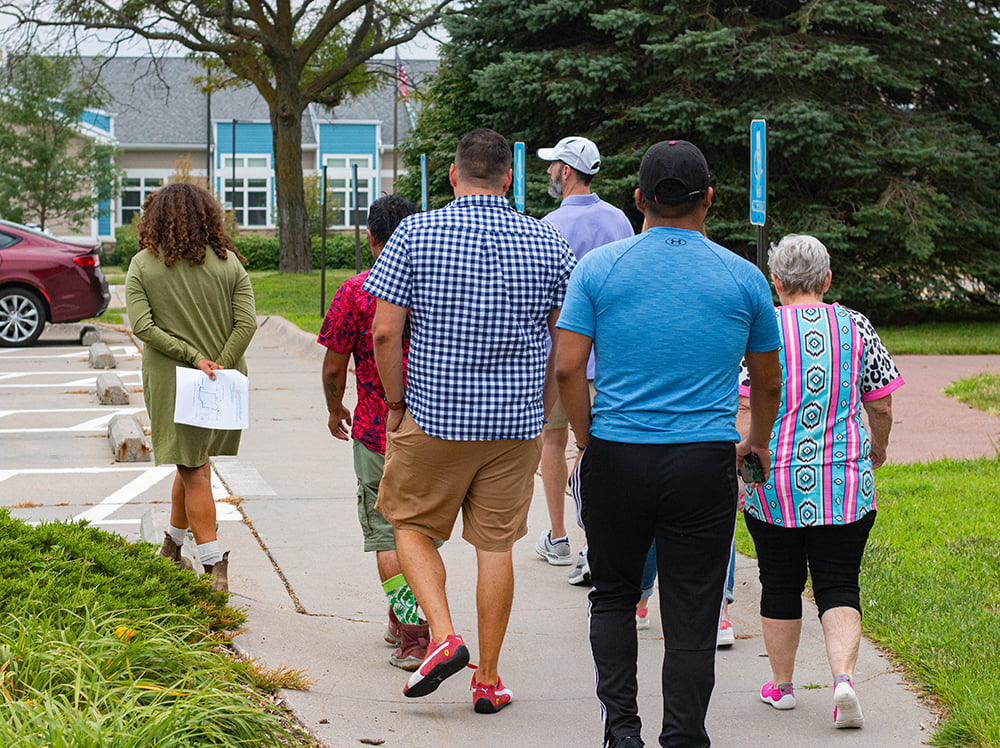Walkability is one of the top concerns we hear from neighborhood groups. Creating walkable neighborhoods fosters healthier, safer, and more vibrant communities. A walk audit is a powerful tool that allows residents to assess the pedestrian-friendliness of their neighborhood and identify areas for improvement. Organizing a walk audit is a fantastic way to start if you’re passionate about making your neighborhood more walkable.
Here are 10 steps to help you plan and implement a walk audit:
Step 1: Assemble a Team
Gather like-minded individuals who share your vision for a walkable neighborhood. Involve community members, local organizations, and government representatives to ensure diverse perspectives and expertise. Having as many residents as possible involved in the audit will make the results more representative of the needs of the whole neighborhood and increase support and follow-through in accomplishing desired changes in the community.
Assign a notetaker and a photographer. These members are essential for the documentation and evaluation of the walk.
Step 2: Define the Scope
Determine the boundaries of the walk audit and the specific areas you want to assess. Focus on key pedestrian routes, intersections, crosswalks, sidewalks, and points of interest.
Step 3: Set a Date and Time
Select a date and time that works for most participants. Consider weekends or evenings to accommodate those with work or school commitments.
Step 4: Notify the Community
Promote the walk audit through flyers, social media, community bulletin boards, and local newsletters. Inform residents about the purpose, benefits, and importance of their participation. Designate a team member to field questions.
Step 5: Plan the Route
Choosing the right route is essential to having a successful walk and outcome. When deciding on the course, consider the distance – keep it around 1 to 1.25 miles. Make sure it covers a variety of places like homes, businesses, churches, schools, community centers, and transit access points. If your neighborhood has a specific area of concern, include it as one of the stops. And don’t forget to highlight any beloved spots during the walk. Ideally, aim for three to five stops to showcase different parts of the area.
Step 6: Create Assessment Tools
Create a checklist of various elements you want to assess, such as sidewalk condition, crosswalk safety, traffic signals, street lighting, presence of ramps, and accessibility features. Try using GPS or mapping apps to track the exact route you take during the walk audit and to mark specific points of interest or areas of concern.
Take pictures of specific locations, hazards, or notable features along the route. If participants are comfortable, consider recording audio or video during the walk audit to capture live discussions and feedback. Encourage participants to take notes on their observations, including positive aspects and areas needing improvement.
Step 7: Gather Necessary Supplies
Provide participants with relevant materials such as clipboards, pens, safety vests, measuring tapes, or other supplies as needed.
Step 8: Conduct the Walk Audit
On the scheduled day, lead the group on the walk audit. At intersections, pause to evaluate safety measures, traffic flow, and pedestrian crossing options. Discuss potential hazards and ways to make crossings safer for pedestrians. The walk audit should be an interactive process. Encourage participants to take notes and photos and share their observations. Discuss findings, highlighting both strengths and opportunities for improvement.
Step 9: Compile and Analyze Data
After the walk audit, compile all the data collected. Sort the data into relevant categories, such as sidewalk conditions, crosswalks, intersections, safety, accessibility, and other vital elements. Analyze the results to identify recurring issues and prioritize the most pressing concerns.
Step 10: Advocate for Change
Utilize the walk audit data to advocate for improvements. Share the findings with local government officials, city planners, and community leaders. Work together to implement changes that enhance pedestrian safety and walkability.
Now you’re ready to organize a walk audit!
Organizing a walk audit for your neighborhood can be a transformative experience, bringing residents together to create positive change. By carefully collecting and analyzing walk audit data, you can build a strong case for improving walkability in your neighborhood and create actionable steps to positively impact the community’s safety and accessibility.

